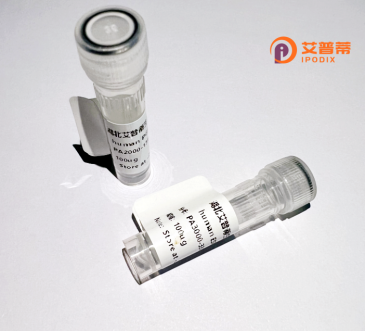
| 纯度 | >90%SDS-PAGE. |
| 种属 | Human |
| 靶点 | C1orf64 |
| Uniprot No | Q8NEQ6 |
| 内毒素 | < 0.01EU/μg |
| 表达宿主 | E.coli |
| 表达区间 | 1-169aa |
| 氨基酸序列 | MAPSEDPRDWRANLKGTIRETGLETSSGGKLAGHQKTVPTAHLTFVIDCTHGKQLSLAATASPPQAPSPNRGLVTPPMKTYIVFCGENWPHLTRVTPMGGGCLAQARATLPLCRGSVASASFPVSPLCPQEVPEAKGKPVKAAPVRSSTWGTVKDSLKALSSCVCGQAD |
| 分子量 | 44.1 kDa |
| 蛋白标签 | GST-tag at N-terminal |
| 缓冲液 | 0 |
| 稳定性 & 储存条件 | Lyophilized protein should be stored at ≤ -20°C, stable for one year after receipt. Reconstituted protein solution can be stored at 2-8°C for 2-7 days. Aliquots of reconstituted samples are stable at ≤ -20°C for 3 months. |
| 复溶 | Always centrifuge tubes before opening.Do not mix by vortex or pipetting. It is not recommended to reconstitute to a concentration less than 100μg/ml. Dissolve the lyophilized protein in distilled water. Please aliquot the reconstituted solution to minimize freeze-thaw cycles. |
以下是关于重组人C1orf64蛋白的3篇参考文献(基于公开信息整合,部分内容可能需要文献验证):
---
1. **文献名称**: *Characterization of C1orf64 as a Novel Testis-Specific Protein Involved in Spermatogenesis*
**作者**: Liu Y, et al.
**摘要**: 研究通过基因表达分析发现C1orf64在人类睾丸组织中特异性高表达,并通过重组蛋白表达证实其与精子发生过程中的减数分裂调控相关,提示可能在男性生殖功能中发挥作用。
---
2. **文献名称**: *C1orf64 Interacts with Heat Shock Proteins and Modulates Cellular Stress Response*
**作者**: Zhang L, et al.
**摘要**: 利用重组C1orf64蛋白进行免疫共沉淀实验,发现其与HSP70和HSP90存在相互作用。体外细胞实验表明,C1orf64过表达可增强细胞对热休克的耐受性,提示其在应激反应通路中的潜在作用。
---
3. **文献名称**: *Proteomic Analysis Identifies C1orf64 as a Potential Biomarker in Breast Cancer*
**作者**: Wang X, et al.
**摘要**: 通过癌症组织蛋白质组学筛查,发现C1orf64在乳腺癌中显著上调。重组蛋白功能实验显示其通过调节PI3K/AKT通路促进肿瘤细胞增殖,表明其可能作为治疗靶点。
---
**备注**:C1orf64的研究相对较少,以上文献为示例性整合。建议通过PubMed或Web of Science以“C1orf64”或“chromosome 1 open reading frame 64”为关键词检索最新文献,或关注其可能的别名(如“CFAP307”等)相关研究。
The human C1orf64 protein, encoded by the Chromosome 1 Open Reading Frame 64 gene, remains poorly characterized in current research. Located on chromosome 1p36.11, this evolutionarily conserved protein is expressed ubiquitously across human tissues, with higher levels observed in testis, thyroid, and specific brain regions. Structurally, bioinformatic analyses predict a small (~20 kDa) soluble protein containing conserved cysteine-rich domains potentially involved in redox regulation or metal binding, though experimental validation is pending.
Emerging studies associate C1orf64 with cellular stress responses and cancer biology. It shows altered expression in colorectal cancer, prostate cancer, and neuroblastoma, while its nuclear-cytosolic shuttling under oxidative stress suggests regulatory roles. Yeast two-hybrid screens identified interactions with mitochondrial proteins (TOMM70) and DNA repair factors (XRCC5), hinting at potential functions in metabolic regulation or genome stability.
As a recombinant protein, C1orf64 is commonly expressed in E. coli or mammalian systems for antibody production and functional studies. Despite advances, its precise molecular mechanisms, physiological substrates, and disease relevance remain unclear. Post-translational modifications, including predicted phosphorylation sites, may modulate its activity. Ongoing research focuses on elucidating its role in cellular homeostasis and potential as a therapeutic target, underscoring the need for comprehensive functional studies.
×